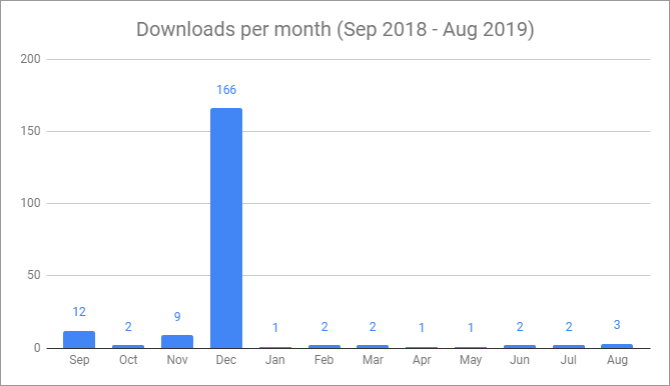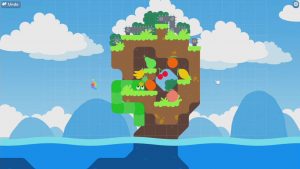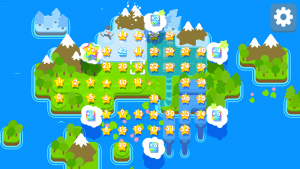Too Many Cows is a puzzle game available on the Google Play Store, launched in September of 2018. From start to finish it took about four months to make, including all the art, code, and puzzles. It was an adapation of a previous GameJam game (Quilpie Ranch) changed to work better for mobile devices.
Prior to starting this project, I’d spent about 10 months trying to collaborate with some friends in order to make a mobile version of one of our previous GameJam games, FasterChef. What I’d learned after almost a year though is that the scope for that project was way too big. Each puzzle required four unique 3D models for the collectables, and every 10 or so levels required entirely new environmental models. Each new puzzle would take anywhere from 5-6 hours to make the content for, and they could be solved in a matter of seconds. The unique content wouldn’t even make the game any more enjoyable, it would’ve just been doing things the hard way for the sake of pride. That’s when I realised I needed to rethink the approach.
I decided that if I was going to make a puzzle game, I could probably reuse the same art assets over the entire game. There would be no need to have variation on the different types of tiles in the level, each tile should do one thing, and there should be no overlap in function. In Quilpie Ranch we had trees, houses, rocks, (and more) that all functioned exactly the same – they blocked the player. While this made things more visually appealing in 3D, it also confused players. The first time they saw a house, they thought they had to interact with it in a special way. By cutting out all the variation for the same tile function, it not only would cut down the amount of work, but create puzzles that were easier for players to understand.
I found the game SnakeBird very inspiring, as a clever puzzle game with a really nice and bright art style. In a blog post they went into how they used 3D models for their art so that they could take advantage of modifying the verticies, and so that it would look good at any resolution. I have much more experience with 3D software than 2D so that was an idea that would work very well for me. Almost everything in the game outside of the UI is actually a 3D model that has been rendered from the front.
All of the puzzle mechanics were implemented within the first few weeks of development, and most of the art too. It almost felt like it was 90% complete even at that early stage, but there was so much extra work in order to get it finished enough to put on the store. Progression between levels, pause/settings menus, sound effects, polish and of course dozens of levels (just to name a few things to do). For the progression I wanted to go non-linear, another thing that I saw SnakeBird do. I saw this as good thing because if a player got stuck on a level they could try a different one instead, and not be totally blocked from progressing. Even though you could play each level sequentially, the order of them unlocking confused a lot of playtesters, so it’s probably not an approach I’ll use again in the future. It’d be better to have linear progression with the option to skip.
One of the criteria for winning the level is to do it within the minimum number of moves. If you find a solution that works but is too many moves, you lose. This number of moves was the minimum number I could find on each level after playing dozens of times. Even with that, some playtesters managed to find faster solutions, and so I updated the answer to be the even more restrictive number. The idea was to make the game more challenging, which worked, but also made it very frustrating. Players could see they were so close to the end but one or two moves short. A better idea may have been to make the move limit an extra achievement, not a requirement for beating the level. This could’ve given the challenge to players who wanted it, and not got in the way of players wanting an easier time.
This game was my first look into putting in adverts, and an IAP (in app purchase) to remove the adverts. This was a bit of a learning curve, but eventually I settled on banner ads plus interstitials, with a 99p option to remove them. I wasn’t completely sure which would be worth more money, the IAP or someone playing through and seeing lots of adverts, but what it comes down to is it depends on the user. Some users are worth pennies for every thousand views of an advert, and one I’ve seen go as high as £100 per thousand views.
I don’t really have the data to say either way which option makes more money. When I was finished with the game I pushed it out to my small circle of social media friends, and got a dozen or so downloads. In the time since then there haven’t been too many more, and my total income from the game is something below £5. The project was never about making lots of money, more about finishing something and getting it out into the world, but it was a little disappointing that not many people got a chance to play it. I spent a small amount of money experiementing with adverts, to see how many people I could bring in. For every £10 I spent I got back less than 10p so it wasn’t worth scaling up.

I’m really happy with how the game turned out, even if it is a little frustrating. I was also amazed that I managed to get something finished from scratch in four months, almost entirely by myself (a couple of puzzles I had some help with). I also learned how to do a bunch of new things, and also how NOT to do a bunch of things. Within a week of shipping, still full of excitement, I’d already started on my next project…
If you’d like to try out the game, it’s free on Android!







